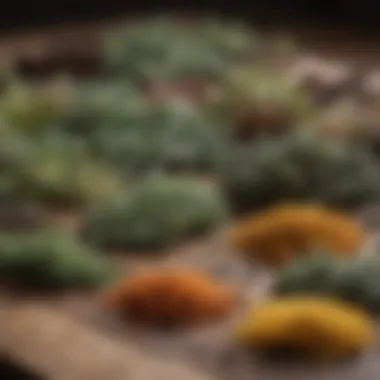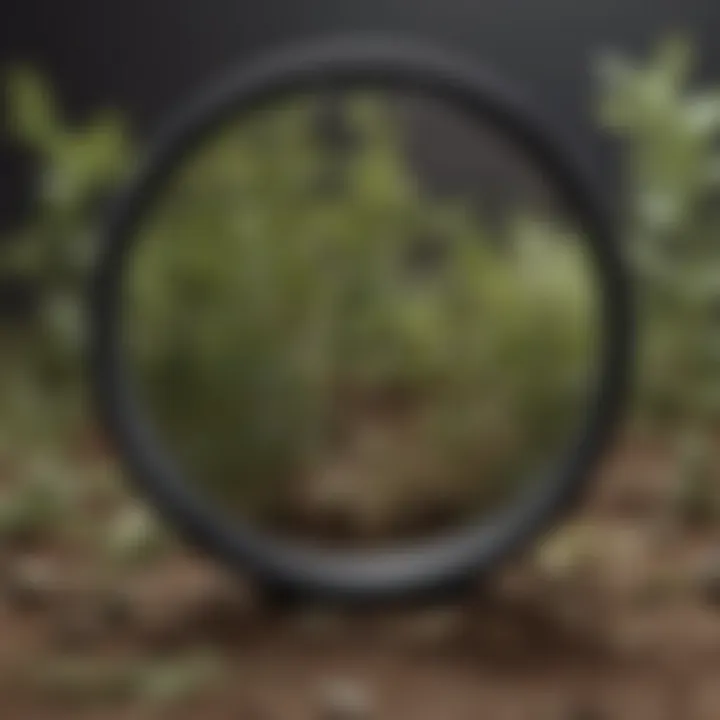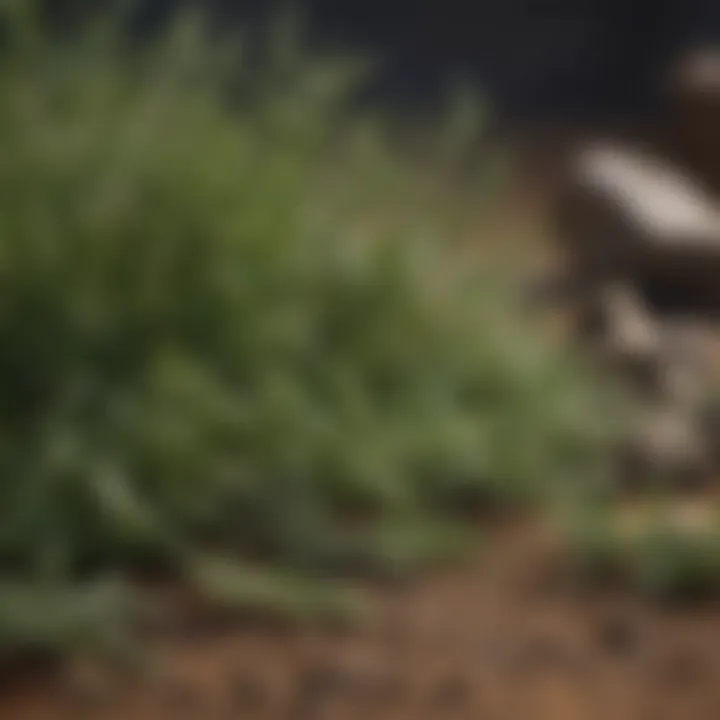Mastering Dried Herb Identification Techniques


Overview of the Topic
Dried herb identification is a vital component of various practices ranging from culinary to medicinal use. Such herbs offer flavor to dishes and contribute to the therapeutic qualities often sought in alternative medicine. With an increasing interest in organic farming and natural remedies, understanding how to identify these herbs becomes paramount. Accurate identification ensures that users are aware of the benefits and potential risks associated with each herb. Misidentification can lead to ineffective remedies or even health hazards, emphasizing the need for comprehensive knowledge and skills in this area.
Background Information on the Significance of the Topic
Dried herbs have been used for centuries across different cultures. They hold significant value not only in kitchens worldwide but also in traditional medicine systems, such as Ayurveda and Traditional Chinese Medicine. The culinary arts benefit from the nuances of dried herbs by enhancing flavors and elevating dishes. On the medicinal side, many herbs have properties that can promote health and treat ailments. Thus, the importance of correctly identifying these plants extends far beyond personal use; it reaches into the realms of agriculture, ecology, and health.
Current Status and Challenges
As the popularity of herbal products grows, several issues come to the fore. The demand for dried herbs can sometimes result in overharvesting, which poses a threat to certain species. Also, with the proliferation of information sources, there is an increase in the amount of misleading or incorrect information available to the public.
Examination of the Current State of Dried Herbs
Several organizations work to conserve diverse plant species. However, the market remains rife with mixtures of different herbs, leading to confusion. This situation makes it challenging for individuals to become proficient at identifying dried herbs. Furthermore, contamination and adulteration of herbal products is another ongoing issue. Consumers might unknowingly purchase products that do not contain what they believe they are buying.
Identification of Challenges
Some common challenges faced during dried herb identification include:
- Variability in Appearance: Different growth conditions can affect how herbs look when dried.
- Lack of Clear Labeling: Many commercial products do not provide adequate information about their contents.
- Limited Knowledge Resources: There are insufficient accessible resources dedicated to the rigorous identification of dried herbs.
"Understanding the specifics of dried herb identification is essential for ensuring safe and effective use, and for promoting sustainability in herb sourcing and use."
Sustainable Solutions
Addressing these challenges requires a multi-faceted approach, combining education with sustainable practices.
Exploration of Sustainable Practices
- Education and Resources: Developing guides and resources that are easily accessible can help enthusiasts and professionals alike. This would empower them to accurately identify dried herbs.
- Sustainable Harvesting: Promoting sustainable harvesting practices among suppliers can reduce overharvesting and preserve plant species. This includes training local farmers on responsible practices.
- Authenticity Testing: Implementing routine testing for product authenticity would help reduce the risk of adulteration in commercial products.
Showcase of Successful Case Studies
Organizations focusing on sustainable agriculture are emerging and garnering positive results. For instance, the United Plant Savers initiatives have successfully educated communities on responsible harvesting, allowing plant populations to thrive while meeting market demands. By sharing their findings in community workshops and educational campaigns, they’ve increased awareness of the importance of maintaining biodiversity.
Impact and Importance
The implications of effective dried herb identification extend into multiple domains. Recognizing dried herbs accurately can significantly influence ecosystem health and agricultural practices.
Analysis of the Impact on Ecosystems and Communities
The misidentification of herbs can have detrimental effects on local ecosystems. Overharvesting certain species can lead to habitat degradation and loss of biodiversity. Communities relying on these herbs for livelihood can suffer economically from unsustainable practices.
Emphasis on Conservation Efforts
Conservation efforts must prioritize the health of both herbaceous plants and the ecosystems they inhabit. For future generations to enjoy the benefits these plants offer, concerted efforts need to be made to educate the public on proper identification. Initiatives promoting the conservation of specific species highlight the intersection between knowledge, practice, and sustainability.
In summary, the journey of identifying dried herbs is complex but essential. It weaves together aspects of ecology, health, and culture. A comprehensive understanding of this process will not only enhance culinary and medicinal practices but will also foster conservation efforts for years to come.
Overview of Dried Herbs
The identification of dried herbs is an essential skill for various applications ranging from culinary to medicinal. Understanding dried herbs allows one to explore their unique properties, flavors, and uses, which enhances both cooking and health practices. This overview serves to establish a foundation for recognizing the importance of accurately identifying dried herbs and the benefits that such knowledge can bring.
Dried herbs provide several advantages, such as extending the shelf life of ingredients while retaining flavors and benefits. They are lighter and more space-efficient compared to their fresh counterparts, making them easier to store and transport. Additionally, dried herbs often have more concentrated flavors, which can elevate the taste profiles of many dishes.
However, the process of identifying dried herbs can be challenging due to the prevalence of similar-looking varieties. This guide addresses these challenges and provides readers with techniques for effective identification.
Definition and Importance of Dried Herbs
Dried herbs are plant leaves, flowers, stems, or seeds that have been dehydrated to preserve their essence and functionality. Unlike fresh herbs, which possess high moisture content and a limited shelf life, dried herbs contain concentrated flavors and aromas. The dehydration process enhances certain qualities while diminishing moisture, making these herbs more resilient to spoilage.
The importance of dried herbs extends across various fields. In culinary arts, they play a vital role in flavoring dishes, boosting nutritional content, and even preserving food. In traditional and modern medicine, dried herbs are utilized for their therapeutic properties, contributing to holistic health practices. Mastering the identification process of these herbs is essential for ensuring that one is using the correct type, which can affect the outcome of both meals and health remedies.
Historical Use of Herbs
The history of herbal usage dates back thousands of years. Ancient civilizations relied upon herbs for various purposes, including medicine and culinary uses. Herbs such as cinnamon and sage were highly valued in trade, indicating their significance.


In many cultures, dried herbs were regarded as essential elements in early healthcare. They were utilized in the form of tinctures, infusions, and poultices to treat ailments and maintain overall health. Ancient texts often documented the use of specific herbs for particular conditions, laying the groundwork for today's herbal practices.
As societies evolved, so did the methods of herb preservation and usage. The transition from fresh to dried herbs enabled greater availability across seasons. This historical understanding of dried herbs showcases their enduring relevance and underlines the necessity of proper identification, as the correct usage of these herbs directly impacts their efficacy and function in both culinary and medicinal settings.
The Science of Identification
Understanding the science of identification is essential for anyone who wishes to accurately recognize and utilize dried herbs. This knowledge is not only fundamental for culinary applications but also crucial for medicinal uses and ecological awareness. Identification goes beyond mere visual recognition; it involves a systematic approach that includes understanding botanical classification, recognizing distinct herb characteristics, and applying specific techniques for accurate identification.
Botanical Classification Systems
Botanical classification systems provide a structured framework for identifying and categorizing plants, including herbs. This system is based on a hierarchy that includes several ranks: domain, kingdom, phylum, class, order, family, genus, and species. Each level offers increasingly specific information that aids in pinpointing the exact identity of a dried herb.
A critical aspect of this classification is the use of Latin names, which helps eliminate ambiguity. For example, the common name "basil" can refer to several varieties. However, naming it as Ocimum basilicum clearly defines the specific type being discussed. This precision is vital in both scientific studies and practical applications in cooking or herbal medicine.
Some key reasons to utilize botanical classification include:
- Accurate Identification: It reduces confusion between similar-looking herbs.
- Effective Communication: Establishes a consistent vocabulary for professionals.
- Preservation of Knowledge: Helps in documenting unique properties linked to each herb.
Understanding Herb Characteristics
Recognizing distinctive characteristics of dried herbs enhances identification accuracy. Each herb presents a unique combination of traits such as color, texture, and aroma. For example, basil has bright green leaves that emit a sweet, slightly peppery fragrance, while oregano may display gray-green leaves with a more robust pungency.
When conducting an identification assessment, consider the following characteristics:
- Color: The shade can indicate the herb's type and freshness.
- Texture: This can include the feel of the leaves or stems when crushed.
- Aroma: Smelling the herb can offer insight into its identity. Fresh herbs often have stronger scents than dried ones, yet some scents remain distinct.
- Basil: Vibrant green
- Oregano: Grayish-green
- Thyme: Delicate, fine leaves
- Rosemary: Needle-like, woody texture
"Understanding the characteristics of each herb is crucial. It provides a tactile and olfactory connection that can lead to more confident identification."
As you delve deeper into the identification of dried herbs, remember to also refer to reliable resources that document these features and classification systems. This knowledge base helps support both casual herb enthusiasts and professionals striving to enhance their herbal practices.
Common Dried Herbs and Their Distinct Features
Understanding common dried herbs and their characteristics is crucial in various contexts, including culinary practices, medicinal applications, and conservation efforts. Each herb possesses unique attributes that influence its usage and benefits. Recognizing these distinct features not only enhances flavor and nutritional value in cooking but also aids in the appropriate application of herbs in traditional and modern herbal medicine. Furthermore, being knowledgeable about dried herbs contributes to sustainable herb collection and promotes a deeper appreciation for biodiversity.
Basil: Aroma and Appearance
Basil is recognized by its distinct aroma and vibrant color. The dried leaves often present a dark green to brownish hue, depending on the drying method. Its aroma is strong and somewhat sweet, making it a popular choice in many dishes, especially in Mediterranean cuisines. When identifying basil, consider the shape of the leaves, which are typically ovate and glossy. The fragrance is the most telling feature, able to distinguish it from other similar herbs. This herb is crucial in balancing flavors and adding depth to recipes.
Oregano: Leaf Structure and Flavor Profile
Oregano is another commonly used dried herb that boasts a unique profile. The leaves are small, oval-shaped, and can sometimes appear fuzzy. When dried, they become crumblier and release a robust, pungent scent that enhances many dishes, notably Italian and Mexican cuisines. Oregano's flavor is distinctly sharp with a peppery taste, often described as warm and earthy. This herb is important not only for its culinary uses but also for its health benefits, given its antioxidant properties. Understanding these traits aids in both cooking and selecting the right herb for health purposes.
Thyme: Identifying Traits
Thyme offers subtle yet complex flavors. Its dried leaves are tiny and often resemble small needles, which can make it tricky to identify at first. The color ranges from green to grayish. When you crumple dried thyme leaves, they release a warm, earthy aroma. This versatility makes thyme suitable for various cuisines, especially French. In addition to culinary uses, thyme is noted for its medicinal properties like antibacterial effects. Being able to recognize thyme’s characteristics ensures its effective application in both cooking and herbal traditions.
"Correct identification of dried herbs can significantly impact culinary success and therapeutic outcomes, emphasizing the need for careful observation and understanding."
By becoming acquainted with these common dried herbs, individuals can make informed choices in their cooking and herbal practices. The ability to differentiate between these herbs enhances flavor profiles in dishes and supports health goals, thereby reflecting a nuanced approach to culinary art and herbal medicine.
Challenges in Identifying Dried Herbs
Identifying dried herbs presents numerous challenges that can hinder both culinary and medicinal applications. Understanding these challenges is essential for enthusiasts and professionals striving for accuracy and proficiency. Recognizing the difficulties can lead to better practices and heightened awareness of the importance of correct identification.
Similarities Among Herbs
Dried herbs can often appear remarkably similar to one another, creating confusion during identification. The differences in appearance may be subtle, often limited to slight variations in color or texture. For example, oregano and marjoram can have similar leaf structures, yet they possess distinct flavor profiles. This can lead to misidentification, significantly affecting recipes and herbal remedies.
Factors contributing to the similarity among herbs include:
- Botanical Family: Many herbs belong to the same botanical family, sharing visual characteristics
- Processing Effects: The drying process can alter an herb's appearance, making identification harder
- Cultivation Variations: Different growing conditions can influence the development of traits used in identification
These elements highlight the need for a careful approach when identifying dried herbs. It is important to pay attention to specific details that may help distinguish one herb from another.


Quality Variations and Their Impacts
Quality variations in dried herbs can have a direct impact on their identification and subsequent uses. Factors such as how the herb was harvested, dried, and stored greatly influence its final quality. High-quality herbs exhibit vibrant colors and strong aromas, making them easier to identify accurately.
Conversely, herbs of lower quality might lose potency, changing their appearance and making identification more challenging. This can lead to the following issues:
- Flavor Discrepancies: Using inferior herbs in culinary applications can alter the intended taste.
- Health Risks: Misidentifying herbs can have medicinal implications, as the wrong herb could be ineffective or harmful.
- Consumer Trust: Poor quality herbs can diminish the credibility of sellers and practitioners.
"The key to mastering herb identification lies not just in knowing the herbs but also understanding their context and quality."
By examining these challenges closely, individuals can improve their identification skills and usage of dried herbs.
Techniques for Effective Identification
The process of identifying dried herbs is essential for both culinary and medicinal applications. Effective identification techniques ensure that individuals can accurately recognize and apply these herbs. This section explores vital methods including visual inspection, sensory evaluation, and supporting research materials.
Visual Inspection
Visual inspection is the first step in recognizing dried herbs. The appearance of a herb can provide immediate indicators of its identity. Factors such as color, shape, and structure are crucial. For example, basil is often bright green to brown in color, while thyme presents with small, oval leaves.
- Color: Herbs should have vibrant colors, which may fade in the drying process. Darker shades can indicate quality.
- Shape: Pay attention to the leaf shape; for instance, oregano has a distinct ovate shape, which differs from the more needle-like leaves of rosemary.
- Texture: The feel of the herb can also be revealing; sage leaves are typically soft, while lavender has a more rugged texture.
Ultimately, combining these visual cues with knowledge from prior research enhances accuracy in identification.
Sensory Evaluation: Taste and Aroma
Sensory evaluation involves engaging the senses, primarily smell and taste. This method often confirms visual identification, providing a richer understanding of the herb. When evaluating herbs, consider these points:
- Aroma: Fresh herbs emit distinct scents. For example, parsley has a mild smell, while dill has a stronger, more pungent aroma. Crushing the leaves can often enhance these fragrances.
- Taste: If safe, tasting a small amount can solidify identification. The flavor of basil is sweet and peppery, while the taste of oregano tends to be more robust and savory. This tactile experience adds depth to identification and can guide their use in culinary dishes.
Research and Reference Materials
Research is fundamental in the process of identifying dried herbs. Relying on authoritative sources enhances confidence in identification. Several resources can aid in this endeavor:
- Botanical Guides: Books such as "The Complete Herb Book" are valuable for detailed descriptions and images.
- Online Databases: Platforms like Wikipedia and Britannica offer extensive information on various herbs, including their uses and identification traits.
- Community Forums: Reddit or Facebook groups dedicated to herbal enthusiasts can provide real-time advice and shared experiences.
In sum, utilizing these research materials promotes accurate identification and broadens knowledge about the features and applications of dried herbs.
"Proper identification of herbs is not only essential for effective cooking but also for understanding their medicinal properties."
Together, these techniques provide a robust framework for anyone looking to improve their skills in herb identification.
Utilizing Technology for Identification
In recent years, the landscape of dried herb identification has been significantly transformed by technology. This advancement is not just a convenience; it alters how enthusiasts, professionals, and researchers approach the identification process. Technology offers innovative solutions that streamline the identification of herbs, allowing for more accuracy and speed. Understanding the role of technology is essential as it enhances the overall experience of working with dried herbs, be it for culinary purposes or herbal medicine.
- Efficiency: Automated systems can analyze data quickly, saving time compared to traditional identification methods.
- Accuracy: Technological tools minimize human error, increasing the reliability of identification.
- Accessibility: With mobile apps and online resources, information on herbs is readily available to anyone with a smartphone or internet connection.
"Utilizing mobile apps and databases is revolutionizing how individuals and professionals identify dried herbs, making the process both easier and more precise."
Mobile Applications for Herb Identification
Mobile applications have become a vital tool for anyone looking to identify dried herbs. These applications range from basic identification aids to more advanced tools that include features like image recognition and database access.
- User-Friendly Design: Many apps are designed with the user in mind, making it easy for both amateurs and professionals.
- Image Recognition: Some applications use algorithms to analyze photographs of herbs and provide possible matches, reducing guesswork.
- In-Depth Information: Apps often come equipped with a wealth of knowledge, offering users insights into the herb's culinary and medicinal uses, origin, and more.
Popular applications include PlantSnap and iNaturalist, which offer extensive databases that help users identify various herbs accurately.
Online Databases and Resources
Beyond mobile apps, a plethora of online databases and resources exists for those engaged in herb identification. These platforms serve as repositories of knowledge that aid users in feeling confident about their findings.
- Comprehensive Databases: Websites such as en.wikipedia.org and britannica.com provide valuable information about various herbs.
- Community Forums: Platforms like reddit.com allow users to seek advice or share experiences regarding herb identification issues. Engaging in discussions can provide new perspectives and techniques.
- Research Publications: Utilizing academic databases can lend insights into recent studies and findings about specific herb varieties, strengthening identification accuracy and knowledge.
The Role of Dried Herbs in Culinary Practices
Dried herbs play a crucial role in culinary practices. Their value extends beyond mere flavor enhancement. These herbs offer a depth that can transform a dish from ordinary to memorable. Understanding the use of dried herbs can enhance both cooking techniques and the overall dining experience. Appreciating this role means recognizing how herbs impact flavor, health, and culinary traditions.


Seasoning: Balancing Flavors
Using dried herbs for seasoning provides an excellent means to balance flavors in dishes. Basil, oregano, and rosemary are just a few examples that can add unique taste profiles. Herbs can introduce herbal notes that brighten dishes. They also can complement or contrast other ingredients, making the dish more complex.
When using herbs, timing matters. Adding these during cooking can intensify flavors, while adding them near the end preserves their freshness. Here are a few considerations for using dried herbs as seasonings:
- Start small: Dried herbs are often more potent than fresh. Begin with a small amount and adjust as needed.
- Combine herbs: Mix different herbs to create unique flavor profiles. For example, mixing thyme and sage can enhance roasted meats.
- Pair wisely: Consider the main ingredients. For tomatoes, basil or oregano work well. For fish, dill can be a good match.
The art of seasoning with dried herbs is not just about adding flavor; it’s about creating a harmony of tastes that elevates the dish.
Health Benefits and Nutritional Aspects
In addition to enhancing flavors, dried herbs offer numerous health benefits. Many dried herbs contain antioxidants, vitamins, and minerals. Incorporating these into your diet can support overall health. Oregano, for example, is noted for its antimicrobial properties. Thyme is rich in vitamins A and C, which contribute to good skin and eye health.
Moreover, using dried herbs can reduce the need for salt, thereby aiding in heart health. This is important for maintaining a balanced diet. Here are some noteworthy nutritional aspects:
- Antioxidants: Many herbs contain compounds that help fight oxidative stress in the body.
- Anti-inflammatory properties: Some herbs like ginger and turmeric may help reduce inflammation, benefitting those with chronic conditions.
- Digestive health: Herbs can be beneficial for digestion. For example, peppermint can soothe gastrointestinal issues.
Incorporating dried herbs into one’s diet can enhance both the flavors of meals and their nutritional profile. Understanding their role in cooking allows for informed choices in culinary practices.
Dried Herbs in Traditional Medicine
Dried herbs play a significant role in traditional medicine, serving as vital components in various healing practices across cultures. Their importance stems from their potential therapeutic properties, which have been utilized for centuries to address diverse health issues. In this section, we will delve into specific uses of herbal remedies, as well as modern approaches that integrate these time-honored practices into contemporary healthcare.
Herbal Remedies and Their Uses
Herbal remedies often serve as the foundation for many traditional medicine systems. For instance, herbs like ginger and chamomile have been recognized for their soothing properties, often used to treat digestive issues or minor ailments.
- Ginger: Used commonly for nausea and digestive discomfort. Its anti-inflammatory properties are well noted.
- Chamomile: Often prepared as tea to promote relaxation and improve sleep. It is also known for its anti-inflammatory and calming effects.
- Echinacea: Traditionally utilized to boost the immune system and combat respiratory infections.
- Peppermint: Commonly used for relieving headaches and digestive tract issues.
These herbs not only offer symptomatic relief but also contribute to overall well-being. Peer-reviewed studies support their effectiveness, backing these traditional claims with scientific evidence.
Modern Approaches to Herbal Medicine
As society evolves, so does the approach to utilizing dried herbs in medicine. Today, there is an increasing trend to combine traditional knowledge with scientific research. This synergy can enhance both the efficacy and safety of herbal treatments.
- Integration with Conventional Medicine: Many practitioners now advocate for a complementary approach, where herbs are used along with standard medical treatments to improve patient outcomes.
- Standardization and Quality Control: Advances in technology have facilitated the standardization of herbal formulations. Products undergo rigorous testing to ensure quality, efficacy, and safety. This has increased trust in herbal remedies among both practitioners and patients.
- Research and Clinical Trials: Ongoing studies aim to explore the variables affecting the effectiveness of herbs, aiming to document their benefits more comprehensively. This includes understanding dosage and potential interactions with conventional drugs.
- Holistic Health Perspectives: The modern approach also emphasizes the holistic nature of health, addressing not just symptoms but overall well-being, encouraging a broader understanding of health.
"The integration of traditional herbal medicine with contemporary medical practices showcases a continuous cycle of learning and adaptation in the pursuit of health and healing."
Sustainable Practices in Herb Collection
Sustainable practices in herb collection are essential for maintaining the balance between human activity and environmental preservation. As dried herbs become increasingly popular in culinary and medicinal uses, ensuring that these resources are harvested responsibly cannot be overstated. The exact techniques used in harvesting have wide-ranging implications, not only for the specific plants but also for the ecosystems from which they come. Well-conceived sustainable practices help to protect biodiversity, maintain ecosystem health, and ensure future availability of these essential plants.
Ethical Harvesting Techniques
Ethical harvesting techniques are crucial for sustainable practice in herb collection. These techniques encourage the responsible gathering of dried herbs, minimizing the impact on plant populations. It is vital to gather herbs in a way that does not deplete their numbers or damage their habitats. Here are some key considerations:
- Permitted species: Familiarize yourself with local laws regarding herb collection. Some species may be protected by law, and harvesting them could have legal repercussions. Always verify the status of harvested plants.
- Harvesting methods: Techniques such as selective harvesting, where only a portion of the plant is taken, help to ensure that the rest of the plant can continue to grow and reproduce. Avoid rooting out entire plants, as this can permanently damage local populations.
- Timing: Harvesting at the right time in the plant’s life cycle ensures optimal quality while allowing the plants to thrive. For many herbs, this means collecting them just before they fully flower, which often offers the best flavor and potency.
By applying these ethical harvesting techniques, individuals can contribute positively to the sustainability of herb species while still enjoying their benefits.
Conservation of Native Herb Species
The conservation of native herb species is another vital aspect of sustainable practices within herb collection. Modern agricultural practices, alongside climate change, pose significant threats to many native herb species. Protecting these plants helps to conserve genetic diversity, a crucial factor for adaptability and resilience in changing environmental conditions. Relevant considerations in conservation include:
- In-situ conservation: This method focuses on preserving herbs in their natural habitat. By protecting their ecosystems, it ensures that herbs can continue to thrive in the wild.
- Ex-situ conservation: This includes the establishment of herb gardens or preserved seed banks, which safeguard species from potential extinction.
- Awareness and education: Raising awareness about the significance of native herbs promotes interest and support for conservation initiatives. Through educational outreach programs, conservationists can inspire a new generation to appreciate and protect these vital resources.
"Conservation of native herb species not only preserves biodiversity but also strengthens local economies through sustainable use."
Closure
The conclusion of this article emphasizes the essential nature of dried herb identification. This is not merely a task for chefs or herbalists; it carries weight across culinary arts, traditional medicine, and ecological awareness. Accurate identification of dried herbs ensures not only the efficacy of their use but also enhances our appreciation for the biodiversity they represent.
Future of Dried Herb Cultivation and Identification
The future of dried herb cultivation and identification is at a crossroads. As we face the challenges of climate change and environmental degradation, sustainable practices become more crucial. Emphasizing ethical harvesting techniques can protect native herb species. This ensures their continued existence while also providing a steady supply for use in culinary and medicinal applications.
Moreover, the integration of technology into this field is promising. Mobile applications and online databases can streamline the identification process. As technology evolves, it can offer more comprehensive insights into herb characteristics, facilitating a deeper understanding among users. With each of these developments, we must be mindful of traditional knowledge as well. Lessons from the past can guide modern practices, creating a balance that respects both science and tradition.
As awareness grows about the importance of conservation, more individuals are likely to engage with herbal practices in informed ways. Education plays a pivotal role here. Through community workshops and educational resources, enthusiasts can become more adept at identifying and using dried herbs responsibly.
The continuous quest for knowledge in dried herb identification will shape future practices, enhance culinary experiences, and ensure that traditional medicinal uses are preserved.
In summary, the future holds much promise for the cultivation and identification of dried herbs. By combining sustainable practices, technological advancements, and community education, we can ensure this field thrives for generations to come.



